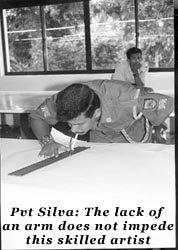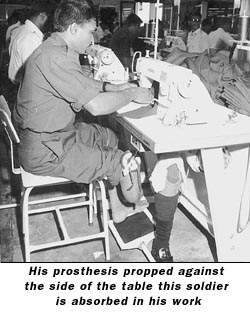 |
 29th November 1998 |
Front Page| |
Beyond the call of duty
No fighting, but creatingManned entirely by disabled officers and soldiers, this unique garment factory produces high quality uniforms for the Army By Hiranthi FernandoThe Army is reputed for its spit and polish and attention to detail in the attire of its men. It is not surprising then, that a garment factory run by the Army is producing high quality uniforms to clothe both officers and other ranks in the Army. What is remarkable is that in this factory, Ranaviru Apparels, the management and workforce is composed entirely of disabled officers and soldiers. Every single person working there from the General Manager, right down to the last helper, has suffered permanent disabilities as a result of the ongoing war. Brigadier Tilak Jayaweera, Director Welfare of the Army, explained that the idea for this factory originated from Brigadier H.I.K. Fernando. Although when it was first mooted, it was rejected on the grounds of not being viable, approval was finally obtained. The Army had a need for uniforms. They paid outside contractors about Rs.60 for tailoring each uniform. However, they were often ill fitting and needed alteration for which the soldier had to pay an additional sum. The Army which has a strength of around 100,000 men, issues two sets of uniforms each year. So there was a ready market. There are apparently about 8000 officers and soldiers who have been permanently disabled by the war. Although they are paid their salaries, many are frustrated and depressed as they have no occupation. And so it was decided to establish the garment factory to tailor the uniforms and also create gainful employment for around 500 disabled soldiers. Some private sector garment manufacturers assisted the Army in setting up the factory and training its personnel. Ranaviru Apparels is located on a ten acre block of land at Yakkala. The land was partly paid for and partly donated by the owner. The entire project was estimated at Rs.56 million. Approximately Rs.15 million more is required to complete the construction. Although the factory is not yet completed and officially opened due to lack of funds, the production of uniforms has already commenced in a systematic and professional manner. Inside the factory building, our first stop was at the Fabric and Accessory Stores.Its walls lined with shelves contained bolts of jungle green fabric and various accessories required for the uniforms. Next we came to the Cutting Section. A paper pattern was laid over a hundred layers of the fabric on a long table awaiting the cutters. In the Assorting Section the numbering of the various parts was done. Major Samantha Rodrigo, the Factory Manager explained that each uniform was made up of 21 components. To ensure that all 21 components of one uniform came from the same layer of fabric, a little numbered sticker was stuck on each component. Later, when the components were put together, these stickers were checked. Maj. Rodrigo said this was necessary since there could be slight variations of shade in the different layers of fabric. Next, the fusing of collars, waist bands and shoulder flaps were done in the Fusing Section. The large factory building had a high roof lined with foil to reduce the heat. Rows of fans were also fitted over the assembly lines. Four assembly lines were operational while two more awaited additional manpower. Two lines handled shirts while the other two handled trousers. Each line was staffed by a Supervisor, Quality Controller, Machine Operators, Bottle Iron Operators and helpers. Most of the machine operators were seen to be amputees. Many of them had their prostheses propped up against the side of the tables while they worked. At the Final Check Point, each garment is checked for flaws. Defective garments are sent back to the assembly line. The neatening-up is also done here. All approved garments are sent to the Pressing Section. The pressed, folded, garments reach the final stage, the Packing Section. They are tagged with the sizes, trouser and shirt matched by number and size and packed in polythene. Finally the finished uniforms are packed in cartons of 50 according to size.
Major E.M.G. Wickremanayake, the General Manager said although machines are available for two more assembly lines, they are unable to go into full production due to the lack of accommodation for the additional manpower required. With all six lines operating, the budgeted output per month is 30,000 uniforms to be achieved by 580 workers. At present, with four lines working, the average output per month is 16,000 sets.
Brigadier Jayaweera, who is the Secretary of the Board of Management pointed out certain shortcomings in the project which needed to be given attention. He explained that disabled soldiers who get medically boarded out are eligible for a pension if they have served 12 years. To encourage them to continue working, they need to be given an incentive. He said this had been agreed to in principle but the details have to be worked out. Another drawback is the lack of recreational facilities for the soldiers living at the factory. Psychologically, it is also important that they should not feel isolated by being confined to live solely among disabled persons. Intermingling with normal people would be an advantage. Despite the initial teething problems, the project is achieving the objectives of producing quality uniforms while providing gainful employment to some disabled soldiers. If the necessary accommodation and improved facilities could be provided, Ranaviru Apparels would reach full production capacity to supply the Army its full requirement in uniforms. |
||
 |
More Plus * It's all there at the Golden Sun
Front Page| News/Comment| Editorial/Opinion| Business| Sports | Mirror Magazine |
|
 |
Please send your comments and suggestions on this web site to |
|
 In
the Sample Room located in the basement, an important function takes place.
It is here that all pattern boards are made for the different sizes. Sergeant
Kulatunge, who has suffered gunshot injuries in his hand and neck, is in
charge of the Sample Room. He explained that before starting production
a few samples of the product required are turned out in the Sample Room.
The samples are sent to the Army Ordinance Depot for approval and confirmation
of order. Pvt. Silva who works in the Sample Room is a skilled artist.
He lost an arm in the war. It is amazing to see him drawing patterns, using
his one hand to hold the paper in place while holding the pen in his mouth
to draw.
In
the Sample Room located in the basement, an important function takes place.
It is here that all pattern boards are made for the different sizes. Sergeant
Kulatunge, who has suffered gunshot injuries in his hand and neck, is in
charge of the Sample Room. He explained that before starting production
a few samples of the product required are turned out in the Sample Room.
The samples are sent to the Army Ordinance Depot for approval and confirmation
of order. Pvt. Silva who works in the Sample Room is a skilled artist.
He lost an arm in the war. It is amazing to see him drawing patterns, using
his one hand to hold the paper in place while holding the pen in his mouth
to draw.  The
two existing accommodation blocks can only house about 200 soldiers since
the lower floor of one is being used for Administration. Six large Army
tents provide temporary billets for about 180 soldiers. These soldiers
have to make use of temporary field toilets. Mess facilities for officers
and sergeants are lacking as well as a proper canteen for those soldiers
who come from their homes for work. For example several disabled soldiers
come daily from the Ranaviru village Keragala. Further, Maj. Wickremanayake
said a mini gymnasium had been constructed by the Gampaha Ranaviru Padanama
but the equipment is needed.
The
two existing accommodation blocks can only house about 200 soldiers since
the lower floor of one is being used for Administration. Six large Army
tents provide temporary billets for about 180 soldiers. These soldiers
have to make use of temporary field toilets. Mess facilities for officers
and sergeants are lacking as well as a proper canteen for those soldiers
who come from their homes for work. For example several disabled soldiers
come daily from the Ranaviru village Keragala. Further, Maj. Wickremanayake
said a mini gymnasium had been constructed by the Gampaha Ranaviru Padanama
but the equipment is needed.